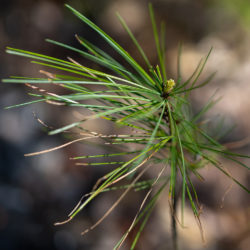Etymology
Pinus is Latin for pine; strobus is Greek for cone.
Native Habitat
Acidic, medium moist, well-drained soil in cool, humid climates.
Garden Uses
An excellent specimen tree for lawns or parks; size and shape can be controlled somewhat through pruning. May be planted as a hedge and sheared regularly to control growth.
Overview
Eastern white pines are found distributed from southeastern Canada and through the northeastern United States. Although they are pyramidal in their early years, they mature to a broad oval habit with an irregular crown. They frequently dominate dry northern forests, and in hardwood forests they often tower above the surrounding trees. This species is the state tree of Maine.
Leaves and Stems
Bluish green needles (to 5" long) are soft to the touch and appear in bundles of five. The trees can grow to over 200’ tall although typically they grow 50-80' in cultivation and 100' tall in the wild and have trunks up to 6’ in diameter. The bark is gray-brown, deeply furrowed with long, irregularly rectangular scaly plates. Branches are whorled (arrangement that circles around the trunk), and the twigs are slender, gray brown when young, becoming gray with age.
Flowers
Pines are gymnosperms, which pre-date flowering plants.
Fruit/Seed
Seed cones are 4-8" long and are usually not produced until the tree is several years old. They are clustered, symmetrical, pendant, conical and gray-brown to pale brown and fall after they shed their seeds. The male pollen cones (strobili) are ellipsoid and yellow ¼ – ½” long and shed pollen from April through June. The seeds are red-brown mottled with black and are compressed egg-shaped and attached to a light brown wing.
Animal Associates
Eastern white pine provides food and habitat for numerous wildlife species. Songbirds and small mammals eat eastern white pine seeds. Snowshoe hares, white-tailed deer, and cottontails browse the foliage; the bark is eaten by various mammals. Northeastern pine forests can support a rich community of breeding birds. Bald eagles build nests in living eastern white pine, usually at a main branch located below the crown top. These trees, especially those with broken tops, provide valuable habitat for cavity-nesting wildlife. Young black bear cubs use large eastern white pine to climb to safety. Insect problems include white pine weevil, bark beetles, white pine shoot borer, Zimmerman moth larvae, pine sawfly, scale and aphids.
Propagation
Shake seeds from a cone that is dry and brittle. Plant them about 1/4-inch deep in moist soil in a shady spot. Germination and initial growth will be slow.
Ethnobotanical Uses
An important timber tree (perhaps more so in the 18th and 19th centuries than now) which was and is valued for its lightweight, straight-grained wood (orange heartwood and white sapwood). It is used for doors, moldings, trim, siding, paneling, cabinet work, and furniture.
Garden Location
Barn Garden, West Woods, South Woods (see garden map)
Sources
USDA FEIS (Fire Effects Information System)
Plant Profile by Kathy Kling

